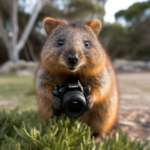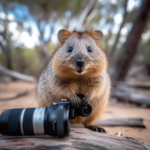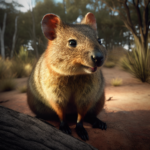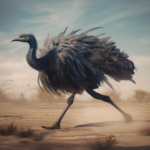The quokka, a small marsupial native to Western Australia, is often regarded as one of the world‘s happiest animals due to its friendly and photogenic nature. However, when it comes to its diet, there is some debate about whether the quokka is a carnivore or herbivore. In this article, we will delve into the eating habits of the quokka and explore the evidence to determine whether it leans more towards being a carnivore or herbivore. So, let’s uncover the truth behind the quokka’s dietary preferences.
Key Takeaways
- Quokkas are herbivores, primarily feeding on grasses, leaves, and stems.
- While they may occasionally consume small insects, their diet consists mainly of plant material.
- Quokkas have adapted to their herbivorous lifestyle with specialized teeth and digestive systems.
- Their diet plays a crucial role in maintaining their unique ecosystem and promoting biodiversity.
Understanding Quokkas: A Brief Overview

A. Origin and Habitat
The quokka, known scientifically as Setonix brachyurus, is a small marsupial native to Western Australia. These adorable creatures are primarily found in the southwestern part of the state, including the mainland and several nearby islands. One of the most well-known habitats for quokkas is Rottnest Island, located off the coast of Perth.
Quokkas have a unique evolutionary history, dating back millions of years. They are believed to have descended from a common ancestor with kangaroos and wallabies. These marsupials have adapted to survive in a range of environments, from coastal scrublands to dense forests.
B. Physical Characteristics and Behavior
Quokkas are often described as the “happiest animal on Earth” due to their friendly and curious nature. They have a compact body, measuring around 50-60 centimeters in length, with a tail that adds an additional 25-30 centimeters. Adult quokkas typically weigh between 2.5 to 5 kilograms.
These marsupials have a round face with a short snout, small ears, and dark, expressive eyes. Their fur is coarse and varies in color, ranging from brown to gray. Quokkas also have a pouch, similar to other marsupials, where they carry and nurse their young.
In terms of behavior, quokkas are primarily nocturnal, meaning they are most active during the night. However, they are also known to be diurnal, meaning they can be active during the day as well. Quokkas are herbivores, with their diet consisting mainly of vegetation such as leaves, grasses, and stems. They have a unique ability to extract moisture from their food, allowing them to survive in arid environments.
Quokkas are social animals and are often found in small family groups. They communicate through a variety of vocalizations, including soft grunts and hisses. These marsupials are also known for their ability to climb trees and swim, making them versatile in their movements.
In conclusion, quokkas are fascinating creatures with a rich history and unique adaptations. Their origin and habitat, as well as their physical characteristics and behavior, contribute to their charm and appeal. Whether you encounter them in the wild or see their adorable photos, quokkas are sure to bring a smile to your face.
The Quokka Diet: Carnivore, Herbivore, or Omnivore?
A. Predominant Food Sources
The quokka, a small marsupial native to Western Australia, is primarily herbivorous, meaning that its diet consists mainly of plant matter. These adorable creatures are often referred to as the “happiest animals on Earth” due to their friendly and curious nature. But what exactly do they eat?
Quokkas have a diverse range of food sources, with vegetation making up the majority of their diet. They are known to consume a variety of grasses, leaves, and stems from different plant species. Some of their favorite food sources include:
-
Grasses: Quokkas graze on various types of grasses found in their natural habitat. They have a preference for young, tender shoots, which provide them with the necessary nutrients.
-
Leaves: Quokkas also feed on leaves from a wide range of plants. They have been observed munching on leaves from shrubs, small trees, and even certain types of vines.
-
Stems: The stems of plants are another important food source for quokkas. They have strong teeth that allow them to chew through tough stems, enabling them to access the nutrients within.
-
Fruits: While quokkas primarily consume vegetation, they also indulge in the occasional fruit treat. They have been known to eat berries, seeds, and even small fruits when available.
It’s important to note that while quokkas are predominantly herbivorous, they have been observed exhibiting some opportunistic behavior. This means that in certain situations, they may consume small insects or other small animals. However, these instances are rare and not a significant part of their diet.
B. Unusual Dietary Observations
Despite their herbivorous nature, quokkas have some interesting dietary observations that set them apart from other plant-eating marsupials. One such observation is their ability to consume plants with high levels of toxins.
Quokkas have developed a unique digestive system that allows them to break down and process toxins found in certain plants. This adaptation enables them to consume vegetation that would be harmful or even deadly to other animals. It’s believed that this ability is one of the reasons why quokkas have thrived in their natural habitat.
Another unusual dietary observation is the quokka’s ability to survive on limited water sources. These remarkable creatures have adapted to their arid environment by obtaining most of their water from the plants they consume. This adaptation allows them to thrive in areas where water is scarce, such as the sandy soils of Rottnest Island, their most famous habitat.
In conclusion, while quokkas are primarily herbivorous, they have some unique dietary observations that make them stand out among other plant-eating marsupials. Their ability to consume plants with high toxin levels and their adaptation to survive on limited water sources showcase their remarkable resilience and adaptation to their environment. So, the next time you encounter a quokka, remember that these adorable creatures are not only the happiest animals on Earth but also fascinating herbivores with some extraordinary dietary habits.
Debunking Myths: Do Quokkas Eat Meat?

A. Evidence Against Carnivorous Behaviour
Quokkas, those adorable and photogenic marsupials native to Western Australia, have often been associated with their seemingly friendly and docile nature. However, there have been misconceptions surrounding their dietary habits. One such myth is whether quokkas are carnivores or herbivores. Let’s delve into the evidence that debunks the notion of quokkas being carnivorous.
1. Dental Adaptations
A crucial aspect of determining an animal’s diet is examining its dental structure. Quokkas possess teeth that are well-suited for grinding and chewing plant matter. Their incisors are broad and flat, while their molars are ridged, allowing them to efficiently process vegetation. These dental adaptations strongly suggest that quokkas are primarily herbivorous.
2. Gut Anatomy
Another piece of evidence lies in the quokka’s digestive system. Herbivorous animals typically have a longer digestive tract, enabling them to extract nutrients from plant material more effectively. Quokkas possess a relatively long cecum, a specialized part of the digestive system that aids in the breakdown of cellulose, a complex carbohydrate found in plant cell walls. This further supports the conclusion that quokkas are herbivores.
B. Instances of Meat Consumption: Anomalies or Patterns?
While the evidence points towards quokkas being herbivores, there have been rare instances where they have been observed consuming meat. These instances, however, are considered anomalies rather than indicative of a carnivorous diet. Let’s explore these occurrences and understand their significance.
1. Opportunistic Behavior
Quokkas are known to exhibit opportunistic feeding behavior, meaning they will consume whatever food sources are available to them in their natural habitat. This includes small invertebrates like insects and spiders. While these occasional meaty snacks may provide additional protein, they do not form a substantial part of the quokka’s diet.
2. Nutritional Supplementation
In some cases, quokkas have been observed consuming small amounts of meat to supplement their nutritional needs. This behavior is often observed in individuals living in areas with limited access to diverse plant food sources. These instances should be seen as adaptive strategies rather than a reflection of their natural dietary preferences.
In conclusion, the evidence overwhelmingly supports the notion that quokkas are herbivores. Their dental adaptations and gut anatomy align with those of other plant-eating marsupials. While there have been rare instances of meat consumption, they are considered exceptions rather than the norm. So, the next time you encounter a quokka, rest assured that it is more likely to be munching on some tasty vegetation rather than hunting for meat.
Are Quokkas Omnivores? A Deep Dive into Their Eating Habits
Quokkas, those adorable and photogenic creatures found in Western Australia, have captured the hearts of many with their friendly and approachable nature. But have you ever wondered what these marsupials eat? Are they carnivores, herbivores, or perhaps omnivores? Let’s take a closer look at the eating habits of quokkas and explore whether they fall into the omnivorous category.
A. Understanding Omnivorous Diets
Before we delve into the specifics of the quokka’s diet, let’s first understand what it means to be an omnivore. Omnivores are animals that have the ability to consume both plant matter and meat. This dietary flexibility allows them to adapt to a wide range of food sources, making them highly versatile in various environments.
Omnivorous animals possess certain physical characteristics that enable them to consume both plant and animal matter. For example, they have a combination of sharp incisors for tearing meat and flat molars for grinding plant material. This dental adaptation allows them to efficiently process a diverse array of food.
B. Comparing Quokka’s Diet with Other Omnivores
When it comes to the quokka’s diet, it’s important to note that they primarily fall into the herbivorous category. These small marsupials mainly feed on a variety of vegetation, including leaves, grasses, stems, and even bark. Their diet consists mainly of plants, making up around 95% of their food intake.
However, quokkas do display some omnivorous tendencies. While plant matter forms the bulk of their diet, they have been observed occasionally consuming small insects, spiders, and even small reptiles. These instances of animal consumption are relatively rare and are considered supplementary to their herbivorous diet.
To further understand the quokka’s dietary habits, let’s compare them to other well-known omnivores. Take bears, for example. Bears have a similar dental structure to quokkas, with sharp incisors and molars suitable for both plant and animal consumption. However, bears have a more balanced diet, with a higher proportion of meat compared to quokkas.
Another example of an omnivorous animal is the raccoon. Raccoons have a diverse diet that includes fruits, nuts, insects, small mammals, and even garbage. Unlike quokkas, raccoons have adapted to urban environments and have become notorious for their scavenging habits.
In comparison to these omnivorous animals, quokkas primarily rely on plant-based food sources. Their occasional consumption of small animals is more of an opportunistic behavior rather than a significant part of their diet.
In conclusion, while quokkas exhibit some omnivorous tendencies by occasionally consuming small animals, their diet is predominantly herbivorous. These adorable marsupials thrive on a variety of vegetation found in their natural habitat, making them an essential part of the ecosystem. So, the next time you encounter a quokka, remember that they are more likely to be munching on leaves and grass than hunting for meat.
Quokkas and Herbivory: The Primary Food Source
Quokkas, those adorable and charismatic marsupials native to Western Australia, have long been a subject of fascination for both locals and tourists alike. One of the most intriguing aspects of their lifestyle is their dietary habits. Let’s delve into the world of quokka herbivory and explore their primary food sources.
A. Preferred Vegetation and Fruits
Quokkas are primarily herbivorous animals, meaning their diet consists mainly of plants. They have a diverse range of preferred vegetation and fruits that they consume to meet their nutritional needs. These plant-eating marsupials have adapted to their natural habitat, including the unique vegetation found on Rottnest Island, their most famous home.
Here are some of the key plant species that quokkas prefer to munch on:
-
Grasses: Quokkas graze on various grass species, such as kikuyu grass and couch grass, which are abundant in their habitat. These grasses provide them with essential nutrients and fiber.
-
Leaves: Quokkas also enjoy feasting on leaves from a variety of plants, including acacia, peppermint trees, and sheoaks. These leaves not only provide sustenance but also contribute to the quokkas’ hydration needs.
-
Fruits: Quokkas have a sweet tooth for fruits, and they particularly relish the juicy offerings of plants like banksias, melaleucas, and quandongs. These fruits provide them with a burst of energy and essential vitamins.
B. Impact of Herbivory on Quokka’s Lifestyle
The herbivorous nature of quokkas has a significant impact on their lifestyle. Their diet plays a crucial role in shaping their behavior, habitat, and overall well-being.
-
Foraging Behavior: Quokkas spend a significant portion of their time foraging for food. They have developed specialized teeth and jaws that allow them to efficiently chew and digest plant matter. Their small size and agility enable them to navigate through dense vegetation in search of their preferred food sources.
-
Habitat Selection: Quokkas are known to inhabit areas with a rich abundance of vegetation. They are often found in forests, woodlands, and coastal heathlands, where they can find an ample supply of grasses, leaves, and fruits. Their habitat selection is closely tied to the availability of their primary food sources.
-
Nutritional Requirements: As herbivores, quokkas rely on plants to meet their nutritional needs. Their diet provides them with essential carbohydrates, proteins, vitamins, and minerals. The vegetation they consume supports their growth, reproduction, and overall health.
-
Ecosystem Role: Quokkas play a vital role in their ecosystem as herbivores. By consuming plants, they help regulate vegetation growth and contribute to nutrient cycling. Their feeding behavior influences the structure and composition of plant communities, making them an integral part of the Australian wildlife.
In conclusion, quokkas are herbivorous marsupials with a diverse diet consisting of grasses, leaves, and fruits. Their preference for specific vegetation and fruits shapes their foraging behavior, habitat selection, and overall lifestyle. Understanding the primary food sources of quokkas provides valuable insights into their dietary habits and their role in the ecosystem. So, the next time you encounter a quokka, remember that they are nature’s plant-eating ambassadors, contributing to the delicate balance of their environment.
Is a Quokka a Carnivore, Herbivore, or Omnivore? The Final Verdict

A. Analysing Dietary Patterns
When it comes to understanding the dietary habits of the adorable quokka, it is essential to examine their eating patterns and preferences. Quokkas, native to Western Australia and primarily found on Rottnest Island, have long been a subject of curiosity due to their unique behaviors and appearance. One of the key aspects of their lifestyle is their diet, which plays a vital role in their overall health and survival.
Quokkas are classified as herbivores, meaning they primarily consume plant-based foods. These small marsupials have a preference for vegetation, including leaves, grasses, and stems. Their diet mainly consists of a variety of plants, including shrubs and herbs, which are readily available in their natural habitat. While they predominantly feed on plants, it is worth noting that quokkas have been observed to occasionally consume small insects or other sources of protein. However, these instances are relatively rare and do not significantly impact their overall classification as herbivores.
B. Impact of Diet on Quokka’s Health and Survival
The quokka’s herbivorous diet has a significant impact on their health and survival. As plant-eating marsupials, they have adapted to efficiently extract nutrients from the vegetation they consume. Their digestive system is specially designed to break down plant matter and extract the necessary nutrients, such as carbohydrates and fiber, from their food sources.
The abundance of plant-based food in their natural habitat ensures that quokkas have a consistent and adequate supply of nutrition. This helps them maintain their energy levels and overall well-being. The consumption of vegetation also provides them with essential vitamins and minerals necessary for their growth and development.
Furthermore, the quokka’s herbivorous diet plays a crucial role in the ecosystem. By consuming plants, they contribute to seed dispersal, aiding in the reproduction and growth of various plant species. This makes them an integral part of the Australian wildlife and the ecological balance of their habitat.
In conclusion, the quokka is indeed a herbivore, primarily relying on plant-based foods for sustenance. While they may occasionally consume small insects or other sources of protein, their diet is predominantly composed of vegetation. This dietary pattern not only ensures their own health and survival but also contributes to the overall ecosystem in which they reside. Conclusion
In conclusion, the quokka is primarily a herbivore, feeding on a diet consisting mainly of plants, leaves, grasses, and shrubs. While it may occasionally consume small insects or other small animals, these instances are rare and not a significant part of its diet. The quokka’s teeth, digestive system, and behavior all align with that of a herbivorous animal. Its ability to thrive on a plant-based diet is a testament to its adaptability and resourcefulness in its natural habitat. Despite its adorable appearance and friendly demeanor, it’s important to remember that the quokka is a wild animal and should be respected and observed from a safe distance.
Frequently Asked Questions
Do quokkas eat meat?
No, quokkas do not eat meat. They are herbivorous animals, primarily feeding on leaves, grasses, and other vegetation found in their natural habitat on Rottnest Island and other parts of Australia.
Are quokkas omnivores?
No, quokkas are not omnivores. They are herbivores, which means they only consume plant material. Their diet mainly consists of grasses, leaves, and bark.
Are quokkas carnivores?
No, quokkas are not carnivores. They are herbivores, meaning their diet consists only of plant material. They do not eat meat or other animal-based food sources.
Quokka: carnivore or herbivore?
A quokka is a herbivore. This means that its diet consists of plant material such as leaves, grasses, and bark. Quokkas do not consume meat or other animal-based food sources.
Is a quokka a carnivore, herbivore, or omnivore?
A quokka is a herbivore. Their diet is plant-based, primarily consisting of leaves, grasses, and bark. They do not consume meat (like carnivores) or a mix of plant and animal material (like omnivores).
Are quokkas herbivores?
Yes, quokkas are herbivores. Their diet consists mainly of plant material, including leaves, grasses, and bark. This plant-eating marsupial does not consume meat or other animal-based food sources.
What are the typical eating habits of a quokka?
Quokkas typically feed during the night, consuming a diet of plant material such as leaves, grasses, and bark. They have a special ability to extract moisture from their food, which helps them survive in their arid natural habitats.
What are the main food sources for a quokka?
The main food sources for a quokka are plant materials. They primarily feed on leaves, grasses, and bark found in their natural habitat. They do not consume meat or other animal-based food sources.
What evidence is there that quokkas are herbivores?
The primary evidence that quokkas are herbivores is their diet and feeding behavior. They consume plant material such as leaves, grasses, and bark, and do not eat meat or other animal-based food sources. Their teeth are also designed for grinding plant material, which is another characteristic of herbivores.
How does the diet of a quokka compare to other marsupials?
Like many other marsupials, quokkas are herbivores and their diet consists mainly of plant material. However, the specific types of plants they eat can vary based on their habitat. For example, quokkas on Rottnest Island may have a different diet than those found on the mainland due to the different types of vegetation available.




